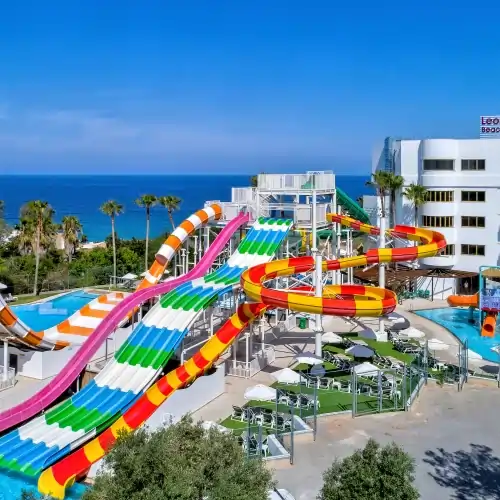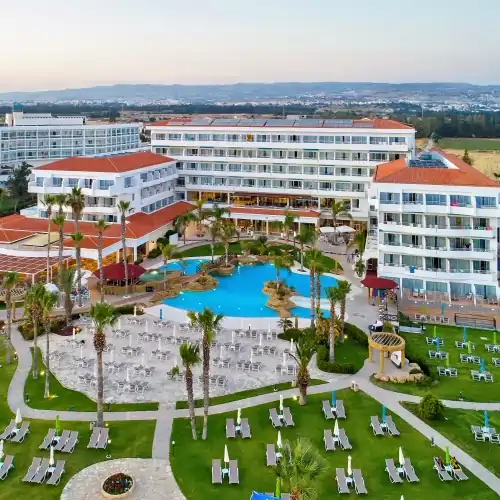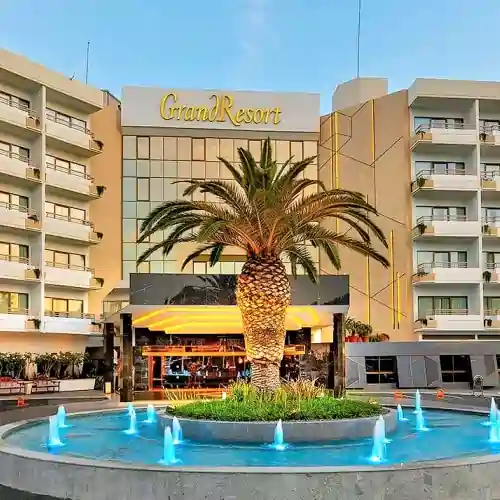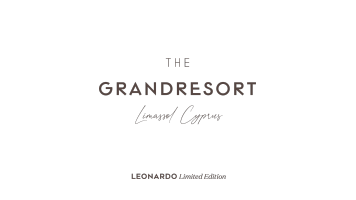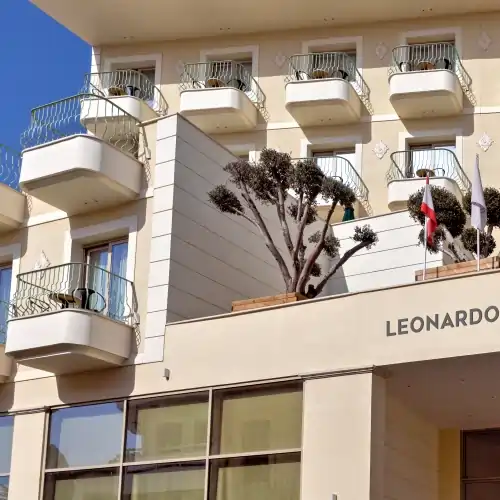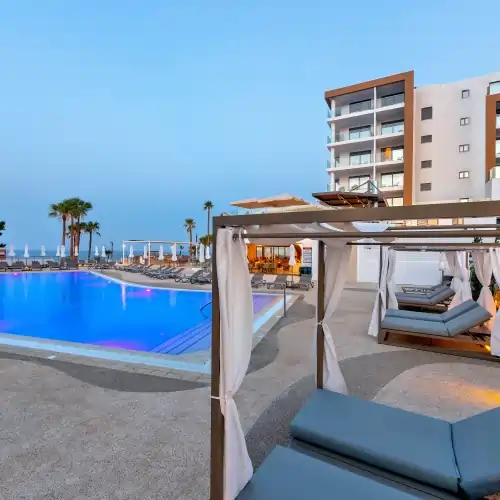- Book Now
- Home Page
- Destinations
- City Guides
- City Guides
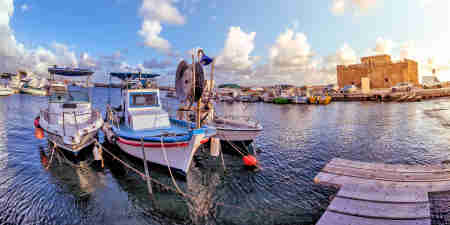 Explore Paphos
Explore Paphos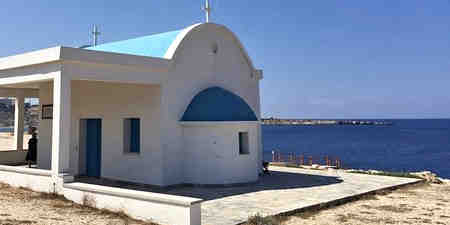 Explore Protaras
Explore Protaras
- Special Offers
- Weddings
- Meetings & Events
- About Us
- Contact Us
- Get A Quote
- Manage your Bookings
- English
St. Paul’s Pillar stands next to the ruins of Panagia Chrysopolitissa, a monumental basilica at its time. It is said that the Roman Governor Sergius Paulus ordered the saint to be tied to one of the columns that now lie in the close proximity to the ancient basilica and flogged for preaching Christianity. The column still stands marked by an inscription in stone.
Here’s Why You Should Visit St. Paul’s Pillar
St. Paul’s Pillar is unremarkable in size, shape, and form. Plus, there’s no historical evidence that the saint was actually whipped here. But the oral tradition turned this stone post into a popular attraction, and the delightful location, within the city of Kato Paphos, makes it a must-see landmark in this part of Cyprus. This quote from 2 Corinthians 11:24 may refer to the event that allegedly happened at the site of what’s today identified as St. Paul’s Pillar:
“24: Five times I received from the Jews the forty lashes minus one.”
St. Paul’s Pillar is not the only thing you will see here. The column lies near the church of Agia Kyriaki, Panagia Chrysopolitissa, and the Gothic Church. The church of Agia Kyriaki is today used by the Anglicans, while the other two monuments lie in ruin. Yet, the place attracts pilgrims and visitors with its archaic appeal.
At its time, about the fourth century AD, Panagia Chrysopolitissa was the largest Christian basilica on the island, an imposing shrine decorated with mosaics, sustained by granite and marble columns with Corinthian-styled capitals. Unfortunately, the basilica was destroyed during the Arab invasion of 653 AD.
It’s not very easy to distinguish the ruins of the basilica from the ruins of the Gothic Church, which was built around 1300 AD. This religious landmark was converted into a mosque during the Ottoman occupation. It had a longer life than the basilica, standing on solid ground until the 16th century when it was eventually destroyed.
The Agia Kyriaki Church was spared demolition during the Ottoman rule. Today, visitors know it under four different names: Agia Kyriaki (St. Kyriaki), Panagia Chrysopolitissa (Our Lady of the Golden City), the Church at St. Paul’s Pillar, and St. Paul’s Catholic Church. Regardless how you choose to call it, you will enjoy your visit. The church honors its namesake saint on July 7th every year.
Read More
Read Less




A pistachio tree with rags and pieces of cloth tied sturdily around tiny twigs and branches guards the entrance to the Agia Solomoni Catacombs. It’s supposed to be sacred, with offerings for Agia Solomoni, the Jewish martyr who was forced to watch her seven sons being tortured and killed by Antiochus IV Epiphanes for refusing to eat pork.
Enter the Chapel of the Seven Sleepers
Considered sacred in Medieval times, the Agia Solomoni Catacombs still enveolop the casual visitor with a sense of mystery. Some people come here to tie pieces of cloth on the branches of the pistachio trees that shades the entrance of the chapel, while others are fascinated by the legend of the seven Maccabees, sons of Solomonia, the Jewish female martyr forced to obeserve the execution of her kin at the hands of Antiochus IV Epiphanes.
Agia Solomoni and her seven sons, Abim, Antonius, Gurias, Eleazar, Eusebonus, Alimus, and Marcellus, were among the first people on Cyprus to embrace Christianity. Their courageous rejection of idolatry offended many of the beliefs of the Hellenistic period (166 BC). The tale behind the cave that serves as the alleged burial place of Agia Solomoni and the seven Maccabees is quite fascinating: seeking shelter from the Romans, Solomonia took refuge in this very cave, only to be walled-in alive. 200 years later, when locals reopened the cave, Solomonia walked out alive.
Legends aside, today Agia Solomoni Catacombs present an intriguing layout, with five rock-cut compartments. In one of them, a flowing spring makes room to even more myths and superstitions. Although the 12-century murals on the walls of the chapel bear the mark of time, their value is unquestionable. Among the scribbles on the plaster of the Agia Solomoni Catacombs you will also find some of the names of the 13th century crusaders.
Read More
Read Less


A UNESCO World Heritage Site since 1980, the Kato Paphos Archeological Park lies within the Nea Pafos area of the city. It is an outstanding tourist destination, noted for its ancient houses and ecclesiastical buildings unearthed from 1962 when the Department of Antiquities commenced digs at the site until today.
Top reasons to see the UNESCO-listed Kato Paphos Archaeological Park
Open daily, year-round, the Kato Paphos Archaeological Park is one of the main tourist attractions on the island. In spring, it’s a colorful sight, with hundreds of crimson poppies showing their pretty heads between the ruins of the ancient city. The countryside around is a sea of canary yellow and neon greens, which contrast in postcard-inspiring vistas against the vestiges of Nea Paphos.
Well marked paths lead the visitor to the wonders of the Roman era, the villas of Dionysos, the House of Aion, Theseus, Orpheus, all flaunting impeccably preserved mosaic floors. These homes are the gems of the complex, which also includes the Agora, the Theater, the House of Four Seasons, the Asklepieion, and the remains of the Saranda Kolones Byzantine castle, to mention the most important landmarks. With so much to see, you could spend hours pottering around the archeological park of Paphos.
The Kato Paphos Archaeological Park lies within the coastal area known as Nea Paphos, the “New Paphos,” which was founded in the 4th century BC by Nicocles, the last king of Palaipafos. In ancient times, during the Ptolemies, New Paphos was the capital of the island. No wonder that the monuments forming the present complex are so richly adorned with mosaics, which are extremely rare, and, according to UNESCO, they are also amongst the most beautiful specimens in the world.
Pictures do not do justice to the sights offered by the Paphos Archaeological Park. The House of Dionysos, one of the most important monuments of the site, stretches over 2000 m², with over 550 m² of its floors covered with mosaics. At the entrance, you are welcomed by a depiction of the sea-monster Scylla. This is the only mosaic from the Hellenic period in the house. You will notice that, compared to other creations that decorate the floors of the House of Dionysos, its colors are faded. But the artistry and the details of the artwork are remarkable.
The House of Orpheus shares its architectural style with the House of Dionysos, with quarters arranged around a central courtyard. In the main room of this building, a mosaic of Orpheus among the beasts impreses the visitor with a delicate balance of blues and earth tones. North of the House of Orpheus, at the House of Four Seasons, as its name implies, the mosaic depicts the mythical personifications of spring, summer, autumn, and winter.
Dating from the 2nd century AD, the Villa of Theseus stands over the ruins of other houses from the Hellenistic and early Roman periods. There’s evidence that this building remained in use until the 7th century AD, most likely as the residence of the governor of Cyprus. It is a massive construction, with over 100 rooms, and mosaics to match the prestige of its inhabitants. Think Achilles´ first bath, Theseus and the Minotaur, Poseidon and Amphitrite, and other mythological scenes added throughout the years to raise the status of this institution.
Part of the House of Aion has not been unearthed, but what archeologists brought to light is a perfect illustration of why the Kato Paphos Archaeological Park has exceptional historical value. This is where you will see the most spectacular mosaic of Paphos, a panel featuring depictions of the newborn Dionysos, the Triumph of Dionysos, the beauty contest between Cassiopeia and the Nereids judged by Aion, Apollon and Marsyas, and Leda and the Swan.
Of the Agora, only the foundations can be observed, while at the site of the Theater on Fabrika Hill, the University of Sydney still conducts archeological research and excavations. Then, you have Saranda Kolones, just north of the harbor of Paphos, an impressive Byzantine fortress, albeit in ruin. Forty granite columns give their name to this attraction of the Kato Paphos Archaeological Park. Built during the Third Crusade, Saranda Kolones (Forty Columns) was a concentric castle, with four imposing towers surrounded by an outer wall with eight defense towers. Only the first floor of the palace was preserved despite some disturbance by looters and the vicissitudes of time.
A day is not enough to visit the Kato Paphos Archaeological Park. There’s a lot to experience among these walls that still tell stories of a glorious past when Cyprus was a force to be reckoned with.
Read More
Read Less



This magnificent underground necropolis is a UNESCO World Heritage Site since 1980. Recognized for exceptional historical value, the Tombs of the Kings (Tafoi ton Vasileon) are the final resting place of Ptolemaic aristocrats and officials who lived in Paphos from the 3rd century BC to the 3rd century AD.
Entombing many great Ptolemaic men, the Tombs of the Kings are a Paphos must-see.
The rock-cut subterranean peristyle graves at the Tafoi ton Vasileon site were never used for royalty. Instead, some 100 Ptolemaic aristocrats and officials were buried here with great pomp. It is believed that the architecture of the Tombs of the Kings was inspired by the Hellenistic necropolises of Alexandria, Delos, Pergamon, and Priene.
Set some two kilometers northwest of the Paphos Harbor overlooking the Coral Bay beach, the Tombs of the Kings are hardly visible from afar. But a sense of sacred and mystery envelops the visitor who steps down among the 12 intact Doric columns that support the peristyle courtyard of Tomb 5 to see what’s left of the necropolis that served as a burial ground for wealthy officials and aristocrats during the Hellenistic period of Cyprus. In Tomb 7, the bones of a rider and his horse entombed together are kept under glass. From the other significant graves of the site, Tomb 4 is the best preserved.
The burial ground was not used just by Ptolemaic aristocrats. There’s evidence that early Christians used the Tombs of the Kings to lay to rest their departed too. Later, in Medieval times, squatters used some of the chambers as housing or workspaces: there’s evidence of a pottery workshop in Tomb 3.
Looted and vandalized for hundreds of years, the necropolis has maintained its sense of pious reverie and can be visited by the public every day, throughout the entire year. At 2.50 €, the admission fee is quite a bargain.
The Tombs of the Kings are a working archaeological site. They have been excavated since 1977, and they are managed and investigated by the Department of Antiquities of the Republic of Cyprus.
Read More
Read Less




